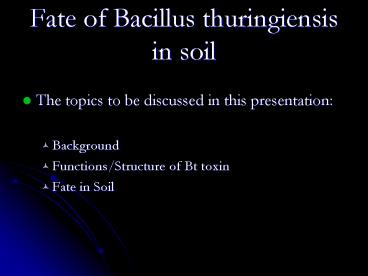Fate of Bacillus thuringiensis in soil - PowerPoint PPT Presentation
1 / 10
Title: Fate of Bacillus thuringiensis in soil
1
Fate of Bacillus thuringiensis in soil
- The topics to be discussed in this presentation
- Background
- Functions/Structure of Bt toxin
- Fate in Soil
2
Background
- Definition Gram () soil bacterium
- cry gene ? delta endotoxin ? protein crystal
- History
- Subspecies
- Bt subspecies kurstaki - controls various types
of lepidopterous insects. (Most commonly used) - Bt subspecies israelensis - effective against
mosquitoes, blackflies' and some midges. - Bt subspecies tenebrionis - effective against
certain beetle (chrysomelids) species and the
boll weevil. - Bt subspecies Japonensis - effective against many
species of scarabid beetles. - Bt subspecies aizawai - used against wax moth
larvae in honeycombs.
3
Pros and Cons of genetically engineering crops
with Bt
- Pros
- Stable during several years of storage
- Resistance of the crystals to inactivation by UV
light - Safety of preparation
- Bt is not known to cause injury to plants
- Cons
- Specificity of strains activity against some
pests, but poor activity against others - Takes longer to kill pests, perceived as less
effective - Fate in Soil/Safety
- More frequent applications
4
Structure/Function of Bt
- Structure
- Bt forms spore and crystal protein inclusion that
consist of d-endotoxins - 3 domains of the cry protein
- Mode of Action
- Kills by Collodial Osmotic Lysis
5
Cry Protein Structure
- Domain 1 responsible for inserting into the gut
membrane and creating a pore where ions can pass
freely - Domain 2 responsible for binding to the
receptors on the epithelial lining of the midgut - Domain 3 responsible to protect the endotoxin
from cleavage by gut proteases, or may be
involved in ion channel formation, receptor
binding, and insect specificity
6
Fate in Soil
- 2 pathways into soil
- Root exudates
- Biomass of plants amended with soil
- Growth
- Mobility
- Toxicity
- Length of stay in soil
- Free toxin vs. bound toxin
- Accumulation
7
Mobility
- Vertical Movement
- cry protein has a tendency to stick to clay
and/or organic matter - Bt is able to survive in soil in which it is not
an indigenous bacterium for more than seven years - Horizontal Gene Transfer
- Important because repeated exposure of an insect
population to a pathogen exerts strong selective
pressure for resistant mutants - Results Found by EPA
8
Toxicity
- Free and bound toxins were insecticidal to the
larvae of tobacco hornworm - Saxena Stotzky 180 days
- LC50s higher for free toxin than bound toxin
- Free or bound have no effect on the growth of a
spectrum of bacteria, fungi, and algae. This
result is in agreement with many observations
9
Growth
- Can compete successfully for added nutrients with
an active soil biota - Can support growth of microorganisms
- free toxin can be readily utilized as a source of
carbon and nitrogen - Bound toxin cannot utilized as a source of
carbon, slightly as a source of nitrogen, and
does not support growth in the absence of
exogenous sources of both available carbon and
nitrogen - confirmed by measurements of oxygen uptake
10
Conclusion
- Overall effect on microorganisms of Bt toxin in
soil - The results indicate that Bt bacteria do not
affect culturable heterotrophic bacteria
populations - does Bt affect carbon cycling functional groups
populations - Future Implications































